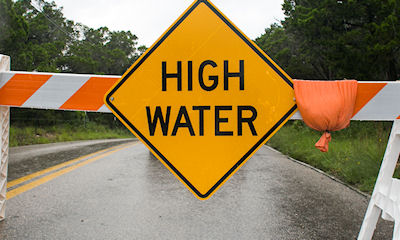
By Brian K. Sullivan
For the second year in a row, much of the U.S. is primed to suffer multi-billion dollar flood losses, with farmers already steeling themselves for planting delays.
Relentless storms that have marched across the Midwest and into the South this winter have already filled rivers to the brim and are threatening to make farm fields too soggy to plant as spring arrives. And there isn’t much to suggest an easing ahead. Heavy rains forecast through next week could push waterways higher where the Mississippi and Ohio meet in Illinois, and into northern Mississippi and Arkansas.
Most states in the American heartland have had two to three times more moisture than normal so far this winter, according to the National Centers for Environmental Information. As February ends and the rains of March and April approach, it won’t take much to cause major problems for farmers in the planting season, homeowners and businesses.
“Odds are we won’t have the $20 billion in losses we had last year,” said Jeff Masters, a meteorologist with Scientific American in Ann Arbor, Michigan. “But the odds are we will see multi-billion dollar losses.”
Last year’s flooding was the costliest in the last decade, easily overwhelming the 40-year average of about $3.7 billion a year.
Flooding on the Ohio, Mississippi and Missouri, as well as their tributaries, can slow the flow of grain, coal, steel, oil and gasoline across the U.S., and put greater demand on road and rail traffic. Faster currents can limit the number of barges in use or shut down waterways completely, affecting markets. Meanwhile, waterlogged fields can slow or even prevent planting.
Last spring, heavy rains kept farmers from putting more than 11 million acres of corn into the ground, the most ever. That added an extra burden to farmers who were already dealing with fallout from President Donald Trump’s trade war with China.
The locked-in wetness this year and in 2019 could be a sign of climate change, according to Jennifer Francis, a senior scientist at the Woods Hole Research Center in Massachusetts. A warmer world means the atmosphere will hold more moisture. This type of “persistence is exactly what we expect to see happen” with climate change, Francis said.
The Ohio river, which feeds the Mississippi with 60% of its flow south, nearly reached major flooding earlier this month at Cairo, Illinois. More rain is due there on the weekend, the National Weather Service reports.
“There continue to be indications that we can expect prolonged and saturating rains during this Sunday night through Wednesday time frame,” the weather service said in a hydrologic outlook. From 2 to 3 inches (7.6 centimeters) of rain is expected in the Cairo area, with as much as 5 inches expected further south.
In the north, the Red River valley that forms the border between North Dakota and Minnesota is another threat to farmers. While flooding is perennially an issue in this area, “the real issue is that there’s overly saturated soils,” said Monte Peterson, a North Dakota farmer, in an interview. “That’s not something I’ve seen in 40 years.”
Peterson still has 1,000 acres of corn he hasn’t harvested from last year, and is bracing for more planting delays this year, “You can’t help but be a little concerned that this is going to delay spring’s work,” he said.
Next week’s rain could push water up to flood levels at Cairo, Jeff Graschel, a hydrologist with the Lower Mississippi River Forecast Center in Slidell, Louisiana. All of that water, as well as the flow from the upper Mississippi and Missouri River, still has to make its way to the Gulf of Mexico so flood conditions will last for weeks.
While much of the U.S. has been wetter than normal, California has been largely dry. Nearly 70% of California is currently abnormally dry or in drought, according to the U.S. Drought Monitor in Lincoln, Nebraska.
--With assistance from Michael Hirtzer.
To contact the reporter on this story:
Brian K. Sullivan in Boston at [email protected]
To contact the editors responsible for this story:
Lynn Doan at [email protected]
Reg Gale, Millie Munshi
© 2020 Bloomberg L.P.
Read more about:
FloodingAbout the Author(s)
You May Also Like




